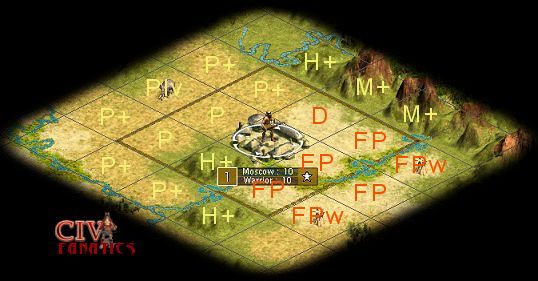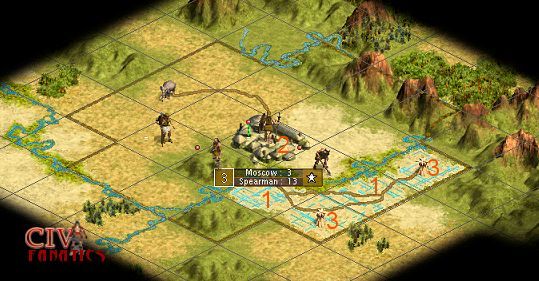 Flood Plain Pop Rushing
Opening
Flood Plain Pop Rushing
Opening
|
Quick Start Challenge Items below this point
Known Bugs and Glitches |
Again if you would like to try your own skills at this developing this start position you may download the exact map that was used for GOTM8 with all the civilizations and barbarians located in the same opening positions. Click here for the instructions to download the GOTM8 start positions replay scenario.
Maximizing population and using it to hurry production
For an approach that relies on “pop rushing” to try and maximize population growth and then use that population to hurry city improvements and/or units whenever possible. We need to bear in mind that “using the whip” to rush production will cause one normally citizen to become unhappy for the next twenty turns for each time we rush a production item. We also need to try and time the hurry events to make maximum use of the conversion of citizens into production shields. The formula that converts citizens to shields exacts a heavy penalty to rush the full production balance of any unit or improvement. A 20 shield spearman costs two citizens to rush while a 19 shield spearman costs only one citizen. A 30 shield settler costs six citizens including the population required to support the settler; a 29 to 21 shield settler costs four citizens; and a 20 shield or less settler costs three citizens. Our population needs to be large enough to support the town even after loosing any citizens that are consumed in the rushing events. We rush our first unit in 3200 BC when we burn one citizen to complete a settler. In 2800 BC we had a citizen die of flood plain disease. We use a single citizen to rush a second settler in 2510 BC but this puts us in a happiness penalty since it has not yet been 20 turns since the last settler was rushed. We use one citizen to rush a spearman in 2310 BC and at this point our “cruel oppression unhappiness” seems to be maxed out. We use one citizen to rush a third settler in 1870 BC but at that point our citizen is so unhappy that we are crippled for the next 20 turns. Here is a timeline of this sequence of events to help visualize the unhappiness due to pop rushing:
The orange text areas indicate where two happiness penalties exist at the same time. These can be offset by a combination of military police units and luxuries if the population of the city is kept small. The red text areas indicate conditions where the unhappiness and population exceed the current ability to keep every citizen working productively. The actual worker move sequence that was followed in this plan consumed 38 worker turns { move-irrigate(4)-road(3)-move to FPw south-irrigate(4)-road(3)-move thru Moscow-move to P+ north of Moscow-road(3)-move to ivory-road(3)-move-move to FPw north-road(3)-irrigate(4)-move-road(3) } to complete irrigation and roads to both the flood plain wheat squares by the year 1990 BC. Two worker movement turns were wasted by duplicated effort moving across rivers or through squares without roads.
Summary
This sequence of worker tasks and movements produces a road network similar to the balanced production approach but instead of improving the plains squares to provide increased shield power we have pushed more irrigation improvements to the southeast to maximize food production.
A conclusion that this integer growth effect hints at is that there is no real value in irrigating additional squares that only increase food production after the two wheat flood plain squares have been fully improved. You basically cannot reduce the number of turns to grow a citizen from three turns down to two turns unless you can sustain a happy population of four or more citizens. When you rely on pop rushing exclusively to balance shields and food production, this limits your max population down to the two to three citizen range because of the happiness balance issues and the accumulated unhappiness penalties that linger for twenty turns. Just for grins, let’s see if we can use elements of the balanced shield production approach and add in just a touch of pop rushing to improve performance. Next Example – A moderately balanced approach with some pop rushing
Other related topics:
|
 ©
2002 by cracker@CivFanatics.com
©
2002 by cracker@CivFanatics.com
All rights reserved. Please read the Terms
of Use.
Send mail to our webmaster with technical
questions about or potential problems with this web site.
 -
-  -
- 




